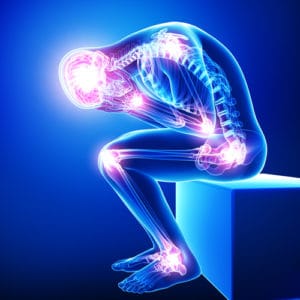
The good news is medical science and research have evolved to enable the workers’ comp community to effectively address this prevalent and costly issue. The bad news is many employers and payers believe the steps needed to move injured workers from chronic pain status to productive individuals are too complicated and too expensive. They are wrong.
Typical case
A 45-year-old male sustains a ‘minor’ twisting injury while lifting something at work. Based on what his physician tells him, he’s anxious to get back on the job and optimistic about his recovery. Seven years later — after umpteen surgeries and a smorgasbord of additional medical procedures — his chronic back pain is such that he cannot stand longer than 2 minutes, uses a walker, and is afraid to move off the couch for fear he might cause more damage and more pain. He takes a long list of medications, and his wife threatens to take the kids and leave. One can only imagine how much is being spent on this injured worker.
Click Link to Access Free PDF Download
“9-Element Blueprint To Create Your Workers’ Comp Employee Brochure”
What could have helped this injured worker soon after his injury — and even years later, is a combination of coordinated care, more accurate diagnoses, and attention to issues beyond just his physical ailment.
Approaches to Pain
In the scenario above, as in many other cases, the physician took a biomedical approach, which assumes all pain symptoms have a specific cause, and once alleviated, the pain will disappear, and the patient will be fully recovered. But for many people, this method just doesn’t work.
Research shows that chronic pain is a complex and dynamic interaction of psychological and social factors as well as biological conditions. A biopsychosocial approach is what is needed; a multidisciplinary effort that includes physical therapy, occupational therapy, psychology, neuromuscular massage, and other experts. Several things could have been done in the above situation..
-
Identify at-risk injured workers
Various potential red flags could have alerted the injured worker’s case manager and others involved in his claim to issues that might exacerbate the patient’s pain. Among them are:
- Getting medications dispensed from his physician.
- Recommendations for implanted devices.
- Getting medical treatment outside the network.
- High medication costs and increased use of medications.
- No functional improvement by anticipated dates, despite various treatments.
- Adverse childhood experiences — such as verbal, physical or sexual abuse; neglect; family dysfunction.
Chronic pain cases require early interventions to prevent them from digressing to the point of the patient described above. The claims management team should have had weekly conversations with the medical providers to get updates on his progress. A thorough medical history should have been done to find out of the initial medical diagnosis was correct. A look at the injured worker’s family situation and other psychological challenges should have been investigated and addressed.
-
Set Realistic Goals
All human beings are not alike, and treating people for chronic pain should not be a one-size-fits-all method. However, the treatment goals for anyone with chronic pain should be the same. These should include:
- Ensure the patient has realistic expectations. An injured worker may not be able to be completely pain-free, but he can still be a functioning member of society. Patients in pain need to understand that and be given tools to help them manage their pain.
- Provide education to help the person gain a locus of control, instead of feeling he is at the mercy of others. The injured worker should be just as involved in medical decision-making as anyone else involved in the claim.
- Quality medical care that is evidence-based. Treatment should be based on scientific studies to guide clinical decision making; ensure consistent, proven medical practices are used; and reduce unproven, ineffective care. The effect is better medical outcomes at lower costs.
-
Use elements of Biopsychosocial Approach
There are a variety of treatments available that have been shown to help at-risk injured workers in chronic pain return to work. Whatever is used should be a process that helps the person gain the skills, knowledge, and behavioral change necessary to avoid medical complications and take charge of his physical and emotional well-being after the injury. Treatments may include:
- Pharmacological interventions to wean the person off opioids.
- Psychological aspects to assist with psychosocial issues.
- Cognitive behavioral sessions that focus on function and coping with pain. They may include relaxation training, guided imagery, desensitization, and addressing anger and entitlement issues.
- Physical and occupational therapy. This may involve aquatics therapy, Tai Chi or Yoga, spine stabilization and stretching, and aerobic conditioning.
- Follow-up care. Since at-risk workers may be vulnerable to reinjury or lapsing into a disability mindset, there should be consistent communication with various referral sources, either face-to-face or by phone.
- Include family and friends. Injured workers’ home and social lives are key factors in recovery, so enlisting family members and friends to support the patient and reinforce positive outcomes should be strongly considered.
All treatments should be undertaken within a coordinated, goal-oriented, functional restoration approach.
Conclusion
Employers and payers that fail to recognize and deal with injured workers with psychosocial issues are doing their companies a disservice. Instead, they should be proactive and identify those with the potential for delayed recoveries, support and encourage early intervention, ensure quality medical providers using evidence-based medicine are employed, and provide whatever elements are needed to help workers in chronic pain regain their functionality.

Contact: mstack@reduceyourworkerscomp.com.
Workers’ Comp Roundup Blog: http://blog.reduceyourworkerscomp.com/
©2023 Amaxx LLC. All rights reserved under International Copyright Law.
Do not use this information without independent verification. All state laws vary. You should consult with your insurance broker, attorney, or qualified professional.

















